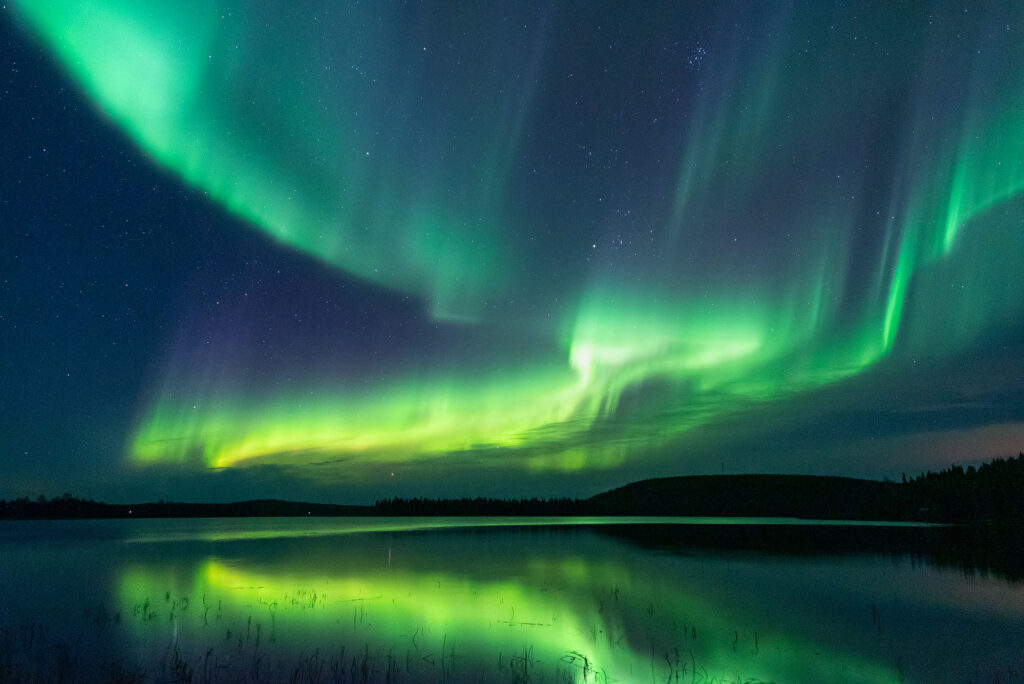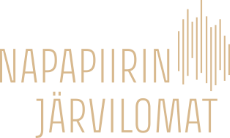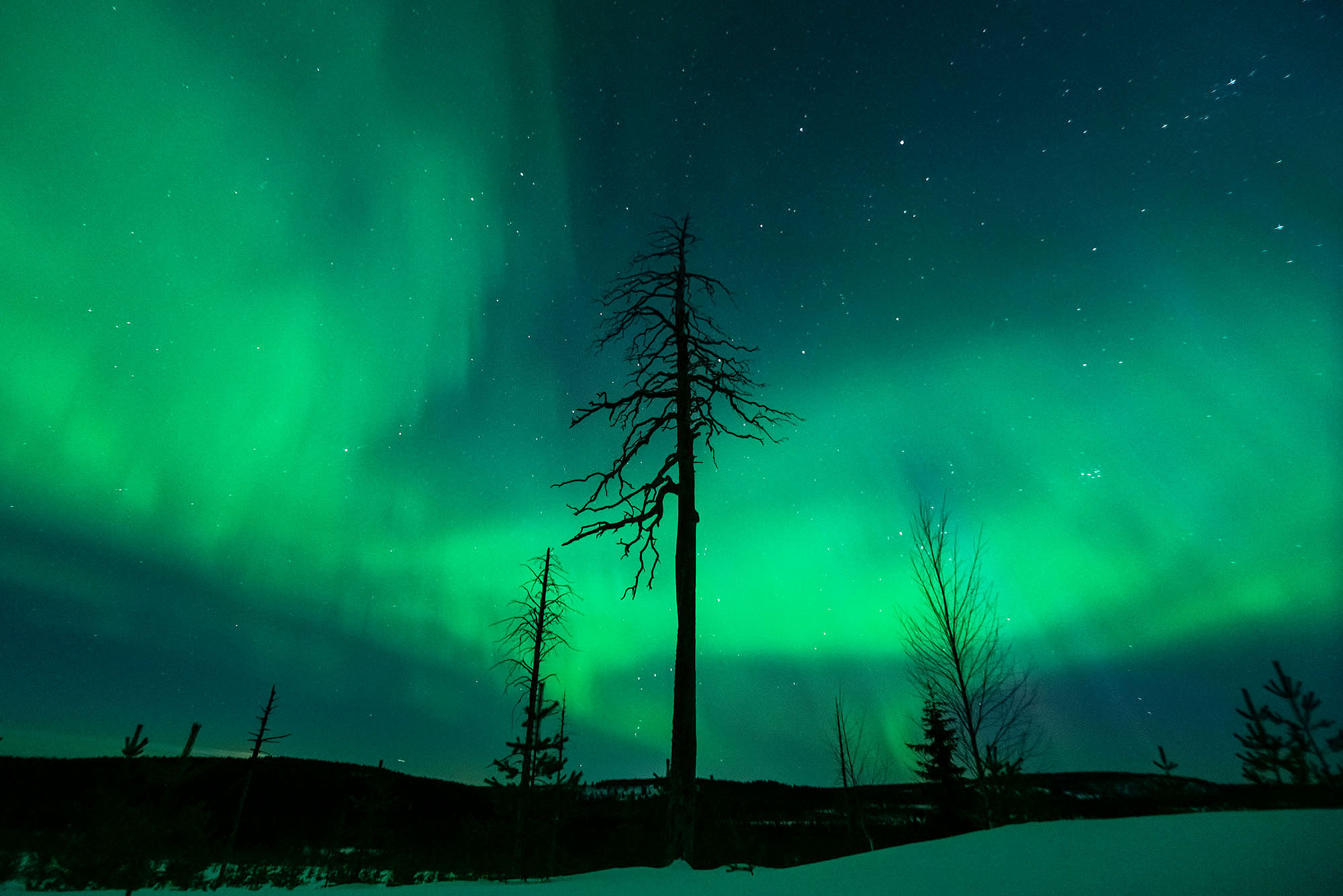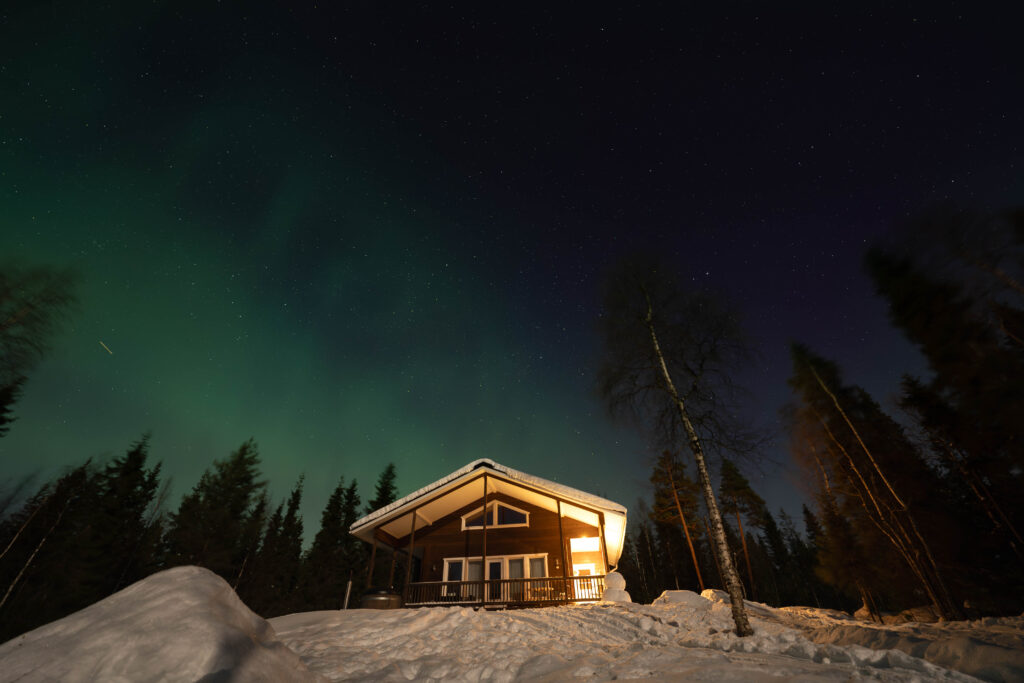Everything you need to know for an unforgettable experience in Finland’s Lapland
Imagine standing under a vast, star-filled sky as waves of green, pink, and violet light ripple above you. This breathtaking natural phenomenon, known as the northern lights, draws thousands of visitors every year to the Arctic Circle. In Lapland, Finland, surrounded by the peace of untouched wilderness, witnessing the aurora borealis becomes more than just a sightseeing activity. It transforms into a personal, once-in-a-lifetime experience.

What are the northern lights?
The northern lights, also known as the aurora borealis, are nature’s own light show. But what exactly causes this ethereal phenomenon?
- Origin: Solar storms on the Sun send charged particles toward Earth.
- Interaction: When these particles meet Earth’s magnetic field, they are guided toward the polar regions.
- Creation: As they collide with gases in our atmosphere, mainly oxygen and nitrogen, energy is released as light. The result is curtains, arcs, and swirls of shimmering color in the night sky.
Why are the northern lights different colors?
The northern lights can appear in a variety of colors, creating unique and ever-changing light displays in the night sky. The colors depend on which gases the charged solar particles collide with and at what altitude these collisions happen.
The most common color is green, which most people associate with the aurora borealis. Less frequently, the northern lights can also appear in red shades. Purple and blue tones sometimes mix with green or appear on their own.
In rare cases, the aurora can show pink, white, or even yellowish tones, depending on the mix of atmospheric gases and the intensity of the solar particles.
Every aurora display is unique. Some nights the sky is filled with soft green waves, while other nights bring multicolored curtains and bright red or purple streaks. No two aurora sightings are ever the same, making each experience special and personal.
Best time to see the northern lights in Finland
In Finnish Lapland, the best time to see the northern lights stretches from September to March, when the nights are long and dark. However, not all months offer the same chances. Typically, the most reliable periods for aurora viewing are during autumn and late winter. In these seasons, the skies tend to be clearer, with less cloud cover compared to the middle of winter, increasing the likelihood of seeing the lights.
Northern lights can appear at any time during dark hours, but they are most commonly seen between 9 PM and 2 AM. The lights often dance most actively around midnight, although sometimes they can be visible as early as early evening, especially when solar activity is strong.
- Best months to see Northern Lights:
- September to March
- Most reliable periods to see northern lights:
- Autumn (September – October)
- Late winter (February – March)
- Best time of night to see the northern lights:
- 9PM to 2AM
- Ideal conditions for seeing the northern lights:
- Cold, clear nights with no cloud cover
- You must also be far away artificial lights, as light pollution from cities like Rovaniemi can block your view of the auroras entirely.
Where to see the northern lights and why Raanujärvi is a great choice
While many tourists book aurora excursions from Rovaniemi, most of these tours actually head north toward us and the Vietonen lake beaches. This might surprise some visitors, but there is a clear reason: in the Vietonen lake, the sky opens up completely, and there is no light pollution from nearby. The vast frozen lakes and open landscapes provide uninterrupted views of the northern sky, giving you the great chance to see the auroras stretching from horizon to horizon.
- Raanujärventie 5955
- Luukonniemi 164 (end of the road)
In contrast, within Rovaniemi town center, light pollution from streetlights, buildings, and traffic forms a light dome over the area, often making auroras invisible even during high activity. This is why clear skies and distance from light pollution are both absolutely essential for successful aurora viewing.
Choosing accommodation directly here, means you do not have to drive long distances at night. You can simply step outside your cabin and watch the sky whenever the auroras appear.
To make aurora watching as comfortable and unforgettable as possible, we’ve built new hidden aurora huts, where you can enjoy the northern lights from your own bed, surrounded by Lapland’s peaceful wilderness.
Lapland legends and the ancient beliefs about the northern lights
For the people of Lapland, the northern lights are more than a scientific event. They are steeped in ancient stories and beliefs that reflect the mystical power of the Arctic.
Revontulet – The Fox Fires
According to the traditional Sámi legend, an arctic fox races across the snowy fells of Lapland. As it runs, its fluffy tail brushes snow into the sky. These snowflakes catch the moonlight and ignite into the lights we see dancing across the sky. This story explains the Finnish word for the northern lights: “revontulet”, which means “fox’s fires.”
Sacred lights and signs
Other legends tell of the northern lights as spirits moving across the heavens. Some believed the lights were the souls of ancestors or otherworldly beings communicating with those on Earth. It was said that whistling at the northern lights would call them closer, though some elders warned against this, believing that drawing the lights toward you could bring misfortune.
In many villages, the auroras were considered sacred, a sign from the spirit world. People treated the lights with deep respect, speaking quietly when they appeared and pausing their work to watch the skies.
Understanding these traditional beliefs adds a spiritual dimension to your northern lights experience, connecting you to the long history of Lapland’s people and their deep relationship with nature.
How to photograph the northernlights
To capture beautiful images of the northern lights, you’ll need a good camera that allows manual settings, a wide-angle lens, and a sturdy tripod to keep your shots steady. Using a remote shutter or timer helps avoid any shaking during long exposures.
Set your camera to manual mode and adjust basic settings like aperture, ISO, and shutter speed to suit the conditions. Experiment to find the right balance, as the brightness of the auroras can change quickly.
Remember to include interesting foreground elements like trees or cabins to make your photos more unique. And most importantly, dress warmly, photographing the northern lights often means spending long periods outside in freezing conditions.
Photography tips for novice photographers
- Compose your image to include foreground elements like trees, cabins, or snow-covered landscapes to add depth.
- Periodically check your photos and adjust settings.
- Dress warmly. Aurora hunting and photography can keep you outside for hours.
- Be patient
Frequently asked questions about the northern lights
What are the northern lights?
The northern lights, also known as the aurora borealis, are a natural light phenomenon visible in the night skies of the Arctic regions. They appear as dancing waves or curtains of green, pink, and purple light caused by particles from the sun colliding with Earth’s atmosphere.
What are the aurora borealis?
Aurora borealis is the scientific name for the northern lights. “Aurora” refers to the Roman goddess of dawn, and “borealis” means “northern.” This term is used especially in scientific contexts, but both names describe the same phenomenon.
Can the northern lights be predicted?
Yes, but only to an extent. Space weather apps and forecasts can give you an idea of possible aurora activity, but conditions can change rapidly. Even with high activity, a cloudy sky will block your view. Check the last forecast here. If you want aurora alerts, we recommend download the app “My Aurora Forecast“.
Do I need to leave Rovaniemi to see the auroras?
Mostly likely yes. Due to light pollution in Rovaniemi city center, the northern lights are rarely visible from there. This is why guided tours often drive visitors north to areas like Lake Vietonen, where the skies are dark and open.
What causes aurora borealis?
Aurora borealis occurs when charged particles from the sun enter Earth’s atmosphere and collide with gases like oxygen and nitrogen. These collisions release energy as light, creating the colorful displays seen in the northern skies.
Where to see aurora borealis?
The aurora borealis is best seen in areas near the Arctic Circle, such as Finnish Lapland. Places like the Vietonen lake beaches offer ideal conditions with dark, open skies and minimal light pollution.
How to see aurora borealis?
To see the aurora borealis, you need to be in a dark, open area far from city lights, under a clear night sky. The best time is between September and March, between 9 PM and 2 AM. Always check aurora forecasts to know when solar activity is high.
When is the best time to see the northern lights in Finland?
The best time to see the aurora borealis in Finland is from September to March. Long, dark nights combined with cold, clear weather offer the best chances to see the lights.
Can I photograph the northern lights with a smartphone?
Modern smartphones with night mode or manual settings can capture the northern lights. However, for professional-quality photos, a DSLR or mirrorless camera with manual settings, a tripod, and a wide-angle lens are recommended.
How long do the northern lights last?
Each northern lights display can last from just a few minutes to several hours. Auroras often come and go throughout the night, so it’s best to be patient and stay outside as long as possible.
Why Raanujärvi is the perfect base for your northern lights trip
Here, the focus isn’t on crowds or commercial tours, but on authentic nature, peace, and personal experiences. Located just north of Rovaniemi, yet far enough from city lights, Raanujärvi offers the perfect blend of accessibility and true wilderness.
This is where the sky opens above frozen lakes, snow-covered forests surround you, and the silence is broken only by the crackle of a fireplace. It’s a place where you can simply step outside your cabin and watch the northern lights without leaving your doorstep.
For those seeking real Lapland, untouched nature, and the best possible conditions for aurora viewing, Raanujärvi is not just a place to visit, it’s a place to experience.
Peace and quiet
Far from mass tourism, surrounded by snow-covered forests and frozen lakes.
Natural dark skies
No light pollution to obscure the auroras.
Lakeside accommodation
Stay right by the lake and watch the lights from your cabin doorstep.
Proximity to prime viewing spots
Most aurora tours from Rovaniemi bring travelers here to the open Vietonen beaches. You can be there already.
Authentic Finnish experiences
Enjoy sauna evenings, snowshoeing, or ice fishing after your aurora adventure.
Your Northern Lights Adventure Awaits
The northern lights are a magical spectacle that leaves a lasting impression on all who witness them. In the serene wilderness of Raanujärvi, beneath silent forests and star-filled skies, you have the perfect chance to experience this Arctic wonder.
Discover peaceful accommodation, where nature, silence, and the magic of the northern lights surround you every night.

 Suomi
Suomi

